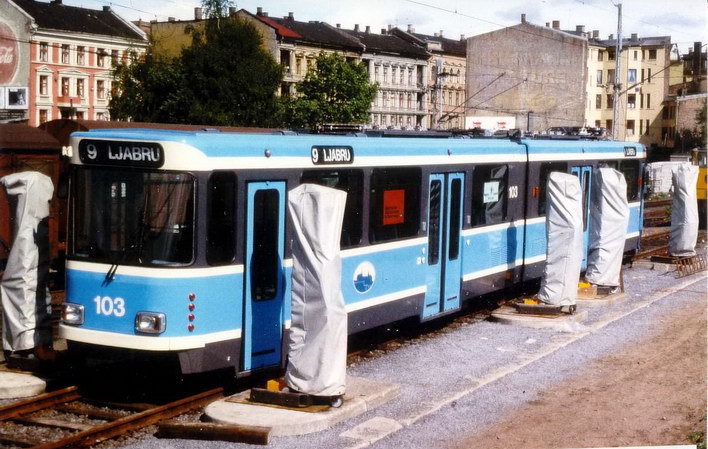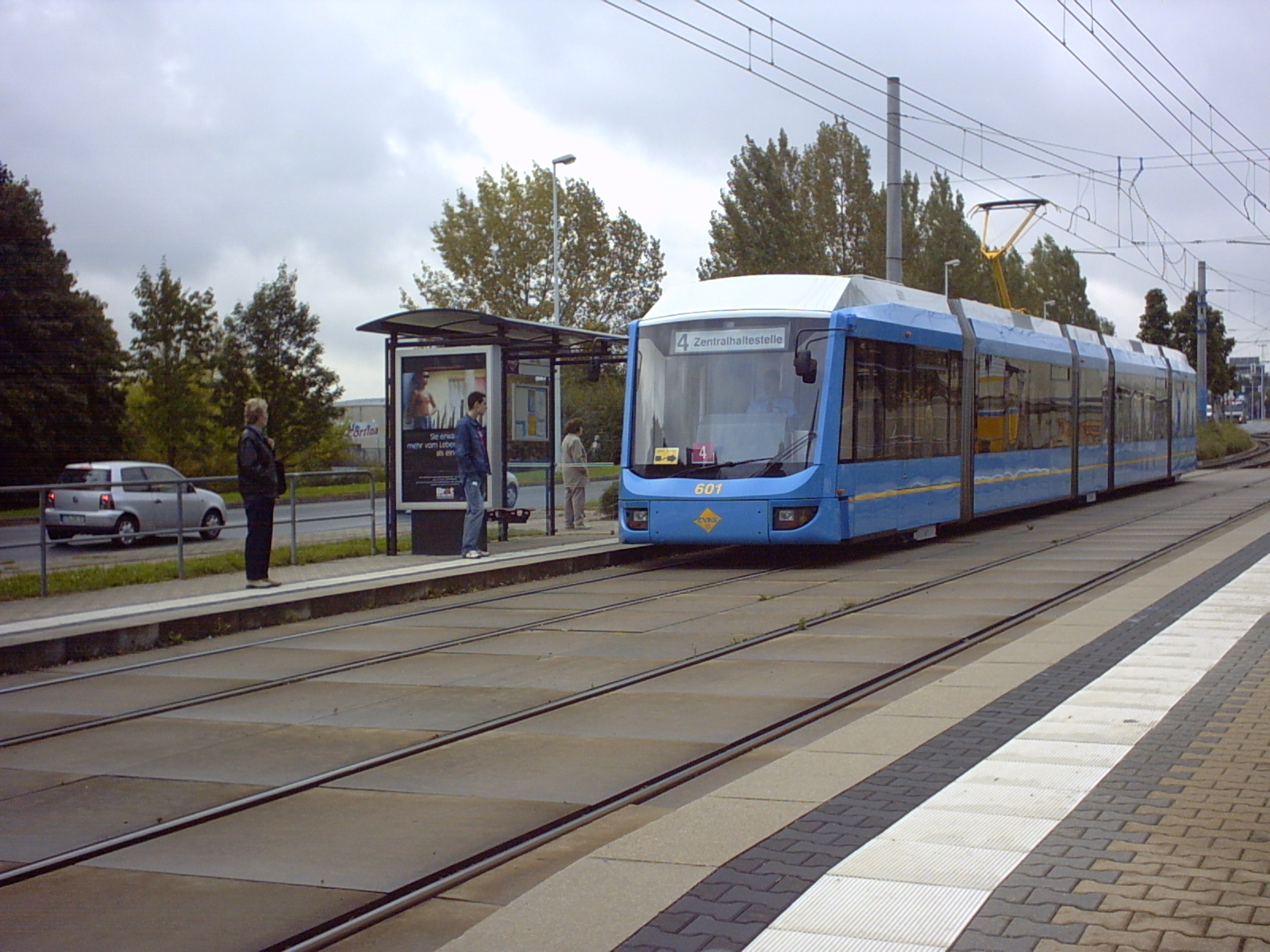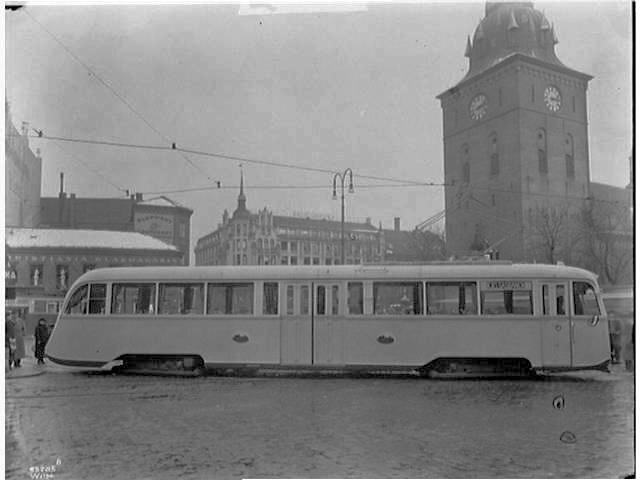|
SL79
SL79 is a class of 40 articulated trams operated by the Oslo Tramway of Norway. The trams were a variation of the Duewag trams that had been developed by the German manufacturer since the 1950s. The six-axle vehicles are unidirectional with four doors on the right side. The trams can seat 77 passengers three and four abreast, with an additional 91 people able to stand. Power output is , provided by two motors on the two end bogies, that supplement a central unpowered Jacobs bogie located under the articulation. The trams are long and wide. They are capable of and have standard gauge. They were built in two series, the first of 25 units delivered in 1982–84, and the second of 15 units delivered in 1989–90. The first 10 units were built by Duewag, while the last 30 were built in Norway by Strømmen. They were numbered 101 through 140. The two series vary slightly in specifications. The trams were ordered in 1979 after the 1977 decision to not close the tramway, after the SM53 ... [...More Info...] [...Related Items...] OR: [Wikipedia] [Google] [Baidu] |
SL95
SL95 is a series of 32 low-floor, articulated trams operated on the Oslo Tramway. The series was built by Italian rail manufacturer Ansaldo/Firema, later known as AnsaldoBreda (now Hitachi Rail Italy), and delivered between 1999 and 2004. Capacity for the eight-axle, three-section vehicles is 212 passengers, of which 88 can be seated. The name derives from being ordered in 1995. Original plans called for the delivery to be between 1997 and 1998. Delivery took many years due to a magnitude of technical flaws, including high noise levels, freezing during the winter and corrosion. The trams are long, wide and tall. The aluminum vehicles weigh and have a power output of . The trams operate all services on lines 13, 17 and 18. Due to their heavy weight and large turning radius they are unsuitable for the other lines. However, they are the only bi-directional trams in the fleet, and are needed on lines 17 and 18 along the Ullevål Hageby Line. The trams cost about each, but discou ... [...More Info...] [...Related Items...] OR: [Wikipedia] [Google] [Baidu] |
Oslo Tramway
The Oslo tram network ( no, Trikken i Oslo, short from ', 'electric') is the tram system in Oslo, Norway. It consists of six lines with 99 stops and has a daily ridership of 132,000. It is operated by , a subsidiary of the municipally-owned who maintain the track and 72 tram vehicles on contracts with the public transport authority . The system operates on standard gauge and uses 750 V DC overhead. Depot, workshops and headquarters are at (at the terminus of lines 13 and 17). There is also a depot at (along lines 18 and 19) that is home to the technical company InfraPartner, which maintains the track for the tram and metro systems in Oslo, and a small office building for . History The first tram in Oslo was opened in 1875 with a short line between Homansbyen west of the city centre, Oslo West Railway Station and a sideline to Grønland, east of the city centre. The first "trams" were in fact horse-drawn vehicles on flanged steel wheels. The first expansion of the line came ... [...More Info...] [...Related Items...] OR: [Wikipedia] [Google] [Baidu] |
SM53
SM53, originally designed MBO and colloquially known as Høka, were a class of 58 trams and 50 trailers built by Høka and Hägglund & Söner, Hägglund for Oslo Sporveier. The units were used on the Norway's Oslo Tramway from 1952 until 2000. The long and wide trams weighed . They had four motors providing a combined power output of , allowing for a top speed of . The first series of thirty trams in 1950, with delivery in 1952 and 1953. These were designated MBO50. The next order was for new bodies for used KES and KSS Class SS, Class SS units. The eight motor units were designated MO and nicknamed Chickens, while the twelve trailers were designated TO. These twin-axle units proved unsuccessful and Oslo Sporveier therefore took deliver of more MBO units. The next batch of twelve MBO55 units were delivered in 1957 and the final batch of eight were designated MBO56 and delivered in 1958. These were built for use on the Lambertseter Line, but were found unsuitable for use on lig ... [...More Info...] [...Related Items...] OR: [Wikipedia] [Google] [Baidu] |
Strømmens Værksted
Strømmens Værksted A/S was an industrial company based in Skedsmo, Norway, specialising in the production of rolling stock. Founded in 1873, it remains as a part of Bombardier Transportation. The plant is located just off Hovedbanen west of Strømmen Station. History The company was established as a mechanical workshop and an iron works in 1873 by engineer Wincentz Thurmann Ihlen, with the name W. Ihlen, Strømmen. The main product was railway cars, with the first being produced in 1874. The Ihlen family retained ownership of the company, with Nils Claus Ihlen taking over the works in 1883, changing the name to ''Strømmens Værksted'', and his sons Joakim and Alf Ihlen in 1908, who transformed it to a limited company. Nils Claus Ihlen would later become Minister of Labour, overseeing the opening of the Bergen Line among others. The iron works were rebuilt to steel works in 1902, and the first sterling produced delivered, soon specializing in propellers up to four tonnes. ... [...More Info...] [...Related Items...] OR: [Wikipedia] [Google] [Baidu] |
Gullfisk
Class B and Class E, normally referred to as ''Gullfisk'' (Norwegian for "goldfish"), were a class of 46 trams built by Strømmens Værksted and Skabo Jernbanevognfabrikk for Oslo Sporveier and Bærumsbanen of Oslo, Norway, in 1937 and 1939. They were the first aluminium trams to operate on the Oslo Tramway and the first bogie trams to operate on street lines. They had contemporary modern electronic equipment, a streamlined shape, and comfortable accommodation. Until 1964, they were also faster than any other Norwegian tramcar or suburban railcar. Six prototype trams were delivered by Strømmen in 1937, with four different motor solutions, from AEG, Siemens, Vickers and Norsk Elektrisk & Brown Boveri (NEBB). None of these were particularly successful, and the 40 serial production trams used conventional motors from ELIN. These were delivered in 1939, with 20 (class E) being used by Oslo Sporveier mainly on the Kjelsås Line, but also on other services. The remaining 20 trams (clas ... [...More Info...] [...Related Items...] OR: [Wikipedia] [Google] [Baidu] |
Sporveien Trikken
Sporveien Trikken AS, formerly Oslo Sporvognsdrift AS and Oslotrikken AS, is the company that operates the Oslo Tramway in Oslo, Norway. Sporveien Trikken is owned by Sporveien, which is again owned by the city council and has an operating contract with Ruter. The company operates 72 trams (40 SL79 and 32 SL95), has 374 employees and headquarters at Grefsen. The company was led by the former Minister of Transport, Torild Skogsholm Torhild Skogsholm (born 18 October 1959, in Bodø) is a Norwegian politician (Liberal Party). in Railway companies of Norway [...More Info...] [...Related Items...] OR: [Wikipedia] [Google] [Baidu] |
Duewag
Düwag or Duewag, formerly Waggonfabrik Uerdingen, was a German manufacturer of rail vehicles. It was sold in 1999 to Siemens with the brand later retired. History Duewag was founded in March 1898 as Waggonfabrik Uerdingen in Uerdingen and produced rail vehicles under the Düwag brand. After merging with Düsseldorfer Waggonfabrik in 1935, railway vehicles were built in Uerdingen, while the Düsseldorf plant produced mainly local traffic vehicles, namely tramway and light rail vehicles. In 1981, the company changed its name from Waggonfabrik Uerdingen to Duewag. Siemens acquired a 60% shareholding in 1989 before taking full ownership in April 1999. In 2001, the Düsseldorf plant was closed with production transferred to Uerdingen. Duewag vehicles were close to a monopoly market in West Germany, as nearly every tram and light rail vehicle purchased from the 1960s onward was built by Duewag. Products * Uerdingen railbus * Buffel (DM'90) *GT8 tramcar in various versions ... [...More Info...] [...Related Items...] OR: [Wikipedia] [Google] [Baidu] |
Jacobs Bogie
Jacobs bogies (named after Wilhelm Jakobs,, 1858–1942, a German mechanical railway engineer) are a type of rail vehicle bogie commonly found on articulated railcars and tramway vehicles. Instead of being underneath a piece of rolling stock, Jacobs bogies are placed between two carriages. The weight of each carriage is spread across the Jacobs bogie. This arrangement provides the smooth ride of bogie carriages without the additional weight and drag. Some Talgo trains use modified Jacobs bogies, that only use two wheels, and the wheels are allowed to spin independently of each other, eliminating hunting oscillation. Background The first fast train using this type of bogie was the German Fliegender Hamburger in 1932. In the United States, such configurations were used throughout the twentieth century with some success on early streamlined passenger trainsets, such as the ''Pioneer Zephyr'' in 1934, various '' Southern Pacific Daylight'' articulated cars, and Union Pacific Rail ... [...More Info...] [...Related Items...] OR: [Wikipedia] [Google] [Baidu] |
CAF Urbos
The CAF Urbos is a family of trams, streetcars, and light rail vehicles built by CAF. The Basque manufacturer CAF previously manufactured locomotives, passenger cars, regional, and underground trains. In 1993, CAF started building trams for Metrovalencia, with the delivery of 16 trams until 1999. This was a variant of a Siemens design and some components were delivered by Siemens, including bogies and traction motors. This design was also sold to Lisbon Trams in 1995; CAF then decided to design and build the Urbos in-house. There are three generations of the CAF Urbos, namely the Urbos 1, Urbos 2, and Urbos 3. The first generation was ordered by the Bilbao tram operator, who received eight trams between 2002 and 2004. The second generation was sold to other operators in Spain, and the third generation is sold in Spain, elsewhere in Europe, the United States, Australia and in the UK. Manufacturing locations include Beasain, Zaragoza and Linares, Spain; Elmira, New York, USA; Ho ... [...More Info...] [...Related Items...] OR: [Wikipedia] [Google] [Baidu] |
Norway
Norway, officially the Kingdom of Norway, is a Nordic country in Northern Europe, the mainland territory of which comprises the western and northernmost portion of the Scandinavian Peninsula. The remote Arctic island of Jan Mayen and the archipelago of Svalbard also form part of Norway. Bouvet Island, located in the Subantarctic, is a dependency of Norway; it also lays claims to the Antarctic territories of Peter I Island and Queen Maud Land. The capital and largest city in Norway is Oslo. Norway has a total area of and had a population of 5,425,270 in January 2022. The country shares a long eastern border with Sweden at a length of . It is bordered by Finland and Russia to the northeast and the Skagerrak strait to the south, on the other side of which are Denmark and the United Kingdom. Norway has an extensive coastline, facing the North Atlantic Ocean and the Barents Sea. The maritime influence dominates Norway's climate, with mild lowland temperatures on the se ... [...More Info...] [...Related Items...] OR: [Wikipedia] [Google] [Baidu] |
1973 Oil Crisis
The 1973 oil crisis or first oil crisis began in October 1973 when the members of the Organization of Arab Petroleum Exporting Countries (OAPEC), led by Saudi Arabia, proclaimed an oil embargo. The embargo was targeted at nations that had supported Israel during the Yom Kippur War. The initial nations targeted were Canada, Japan, the Netherlands, the United Kingdom and the United States, though the embargo also later extended to Portugal, Rhodesia and South Africa. By the end of the embargo in March 1974, the price of oil had risen nearly 300%, from US to nearly globally; US prices were significantly higher. The embargo caused an oil crisis, or "shock", with many short- and long-term effects on global politics and the global economy. It was later called the "first oil shock", followed by the 1979 oil crisis, termed the "second oil shock". Background Arab-Israeli conflict Ever since the recreation of the State of Israel in 1948 there has been Arab–Israeli conflict in the ... [...More Info...] [...Related Items...] OR: [Wikipedia] [Google] [Baidu] |
Aftenposten
( in the masthead; ; Norwegian for "The Evening Post") is Norway's largest printed newspaper by circulation. It is based in Oslo. It sold 211,769 copies in 2015 (172,029 printed copies according to University of Bergen) and estimated 1.2 million readers. It converted from broadsheet to compact format in March 2005. ''Aftenposten''s online edition is at Aftenposten.no. It is considered a newspaper of record for Norway. ''Aftenposten'' is a private company wholly owned by the public company Schibsted ASA. Norway's second largest newspaper, ''VG'', is also owned by Schibsted. Norwegian owners held a 42% of the shares in Schibsted at the end of 2015. The paper has around 740 employees. Trine Eilertsen was appointed editor-in-chief in 2020. History and profile ''Aftenposten'' was founded by Christian Schibsted on 14 May 1860 under the name ''Christiania Adresseblad''. The following year, it was renamed ''Aftenposten''. Since 1885, the paper has printed two daily editions. A Sund ... [...More Info...] [...Related Items...] OR: [Wikipedia] [Google] [Baidu] |





